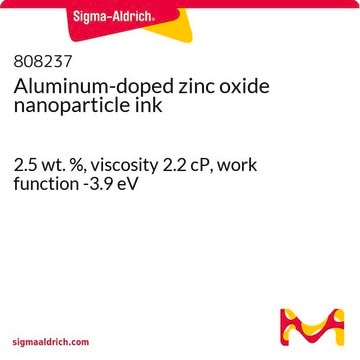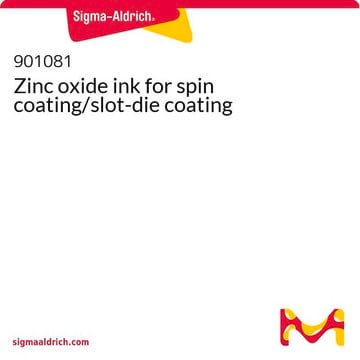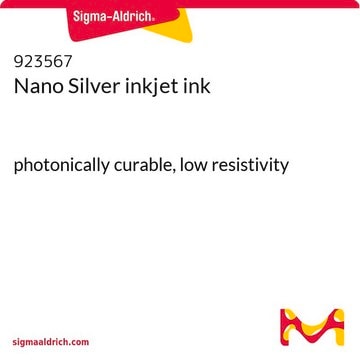901092
Aluminum-doped zinc oxide ink for spin coating/slot-die coating
Synonim(y):
AZO dispersion, AZO ink, Al-doped ZnO ink, Helios′Ink H-DZ41006 semiconductive ink
Wybierz wielkość
1230,00 zł
Wybierz wielkość
About This Item
1230,00 zł
Polecane produkty
opis
Conductivity: 10-3-10-4 S/cm
Work function: 3.6 ± 0.1 eV
Poziom jakości
Formularz
liquid (dispersion)
opór arkusza
10-20 Ω/sq (in combination with silver nanowires)
kolor
slightly yellow to clear
napięcie powierzchniowe
23 mN/m±5 mN/m
lepkość
<4 mPa.s(20 °C)
pojemność
≥0.9 % loading (Nanoparticles loading)
Opis ogólny
This ink shows great performance on spin coating and slot die coating and is compatible with various flexible substrates (Kapton®, PET, PET/ITO, etc.) but also glass/ITO.
The use of Helios′Ink H-DZ41006 semiconductive ink is greatly improving the devices performances by reducing the roughness of the TCE without a negative impact on the electrical conductivity and the transparency. Life time of the devices is also increased.
The use of Helios′Ink H-DZ41006 provides ETL layer with high performances. In addition, compared to standard ETL, the PCE not retained even with higher thickness.
Cechy i korzyści
- Easy deposition under atmospheric conditions (temperature and pressure).
- Good optical performances (visible light transmission >90%).
- Non CMR ink.
- Compatible with ITO layer and Ag NWs layer.
- Compatible with most flexible substrates.
- Low drying temperature making printing onto flexible substrates possible.
Uwaga dotycząca przygotowania
Can be homogenized for 5 minutes in an ultrasonic bath in order to get rid of any aggregates.
Drying conditions: Oven, IR oven, vacuum oven.
Clean-up solution: Ethanol/Acetone.
Informacje prawne
Hasło ostrzegawcze
Danger
Zwroty wskazujące rodzaj zagrożenia
Zwroty wskazujące środki ostrożności
Klasyfikacja zagrożeń
Aquatic Chronic 3 - Eye Irrit. 2 - Flam. Liq. 2 - STOT SE 3
Organy docelowe
Central nervous system
Kod klasy składowania
3 - Flammable liquids
Klasa zagrożenia wodnego (WGK)
WGK 1
Temperatura zapłonu (°F)
58.1 °F
Temperatura zapłonu (°C)
14.5 °C
Wybierz jedną z najnowszych wersji:
Masz już ten produkt?
Dokumenty związane z niedawno zakupionymi produktami zostały zamieszczone w Bibliotece dokumentów.
Produkty
Professors Tokito and Takeda share design principles and optimization protocols for organic electronic devices, focusing on flexibility and low cost.
Active Filters
Nasz zespół naukowców ma doświadczenie we wszystkich obszarach badań, w tym w naukach przyrodniczych, materiałoznawstwie, syntezie chemicznej, chromatografii, analityce i wielu innych dziedzinach.
Skontaktuj się z zespołem ds. pomocy technicznej









